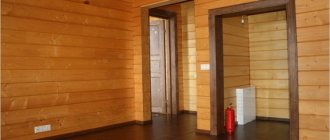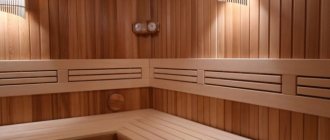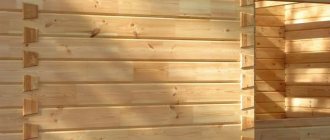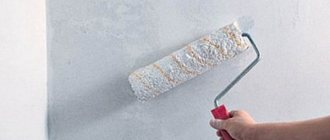Briefly about the main thing
To process lining in a bathhouse, materials that are resistant to temperature changes, humidity, and washing are used.
Also important is inertness to fungus, mold, bacteria, and a safe composition for humans. When heated, many materials release toxins and other harmful substances, so the use of antiseptics, fire retardants, drying oils, varnishes with solvents and acrylic resins is unacceptable for the steam room.
For walls and ceilings, impregnations, mastics, oils and some varnishes are used. For shelves only oil or wax based formulations. This prevents the formation of a thick film to avoid burns.
Bleach is used in any room of the bathhouse, but before further processing of the wood, it is necessary to wait until the chlorine evaporates and the hydrogen peroxide decomposes.
Antiseptics and fire retardants are classified as pre-treatment agents for wood, but are not used as independent coatings. They protect the lining and help reduce the consumption of the finishing coating.
Types of coatings
The wood in the bathhouse is coated with paint to reduce exposure to moisture and high temperature.
The steam room and washing room are subject to the greatest load. However, this load is different.
- In a sauna, the air temperature can rise to 110°C. However, the humidity here is low. Paint for such a room must withstand heat, but may be sensitive to water.
- In the steam room, the humidity is much higher - from 70 to 100%, depending on the type of bath. The temperature is noticeably lower – it rarely rises above 60°C. The finishing material must be resistant to both water and steam and temperature changes.
- In the washing room, the temperature is not higher than a comfortable +30°C, but the humidity here can be high - 90–100%. The paint chosen is as waterproof as possible.
In practice, painting the inside of a bathhouse, especially a log house, is not a good idea. Any paint will be less resistant to the above factors than the wood itself. But if there is no other way to protect the finish, they also resort to painting.
Oil impregnations and varnishes
Effect of oil impregnation against moisture
A bathhouse is a structure used with a certain frequency. The high temperature in the steam room is maintained only during the procedure. Then the room is specially ventilated, cooling to a low temperature.
In this mode, the boards are more likely to dry out and become covered with cracks rather than mold and rot. Therefore, oil impregnations and varnishes are best suited for treating the steam room.
The oil penetrates the top layer of the wood, forming not a film, but a structure impenetrable to water. At the same time, the wood continues to expand normally and decrease in volume as the temperature changes. This way the oil prevents cracks from appearing.
Antiseptics for bath floors
The floor in the bathhouse is covered with antiseptic impregnations against rotting.
It is not enough to paint the steam room or sauna in the bathhouse - you need to take care of protection from rotting. The weak link in this room is the floor. Water flows onto it, steam is deposited, and it comes into contact with a cold concrete base or soil. To prevent the wooden floor in the bathhouse from rotting 5-6 years after construction, it must be treated with antiseptic impregnations.
Liquids based on substances that have a disinfecting effect:
- Acrylic-based water-based compositions. Moisture-resistant, prevent the growth of fungus, but are not very effective. More suitable for processing the dressing room.
- Organic – based on oils. They are better absorbed by wood and are moisture resistant.
- Products based on wax and urethane oils are absorbed to great depth. In addition to the water- and dirt-repellent effect, they give the timber and lining velvety and softness.
- Combined compositions increase both water resistance and fire safety.
It is strictly forbidden to use compounds that release toxins when drying to treat wood.
Water-dispersed impregnations
Acrylic paints reduce the harmful effects of moisture on wood
You can paint the logs inside the sauna or steam room with water-soluble paints.
The floor and walls in the steam room are painted with water-dispersed acrylic paint. It is quite resistant to temperature changes and does not prevent the penetration of steam. The hiding power is usually low, but the wood can be given any color. The downside is its low durability, the paint washes out quite quickly.
Paint for a bathhouse in a washroom should be as resistant to water as possible. The best products are latex or polyurethane based. For a dressing room or rest room finished with plaster, you can use any compositions marked “for interior decoration.”
The paint forms a film coating on the surface of the wood. And oil compounds penetrate inside, so in the steam room the walls are treated with impregnations.
Wax-based impregnations
Wax paint does not allow moisture to pass through, so it is well suited for baths and saunas
Wax is offered in liquid - viscous composition, and solid. The latter is somewhat more difficult to apply without the habit, but the treatment is carried out less frequently. The product does not create a sticky film and does not attract dirt.
If you only need to protect surfaces from water and steam, wax is more suitable. It is transparent, does not hide the structure of the wood, has some antioxidant activity, and therefore prevents the darkening of the wood.
Water-based polyurethane varnish
This is a kind of resin solution, where water, ethanol, and ether are used as a solvent. For the bath, choose water-soluble varnishes. They are resistant to high temperatures and to acids, oils and salts.
Polyurethane varnish is wear-resistant. Since it is based on water, the varnish layer does not create increased tension on the surface of the wood, and therefore is not prone to cracking. And since the resins polymerize already during drying, there is no subsequent peeling.
Painting inside
There is an article on our website that talks a lot and in detail about what baths are built from and how they are finished from the inside.
Then you can simply follow the links that specify each of the options. On design issues we will have this section. The structure itself can be erected from brick or blocks, wood, or on a frame with insulation. This is, so to speak, the basis. And then most people just take it and cover it with clapboard. Even if it is a log house or timber.
This is done because it is cold and you want to warm yourself up. A gap is made under the lining, which separates it from the insulation placed on the wall. It turns out to be such a false wall. This applies to any base.
However, not all owners do exactly this. And it happens that either by design the bathhouse has a purely brick wall without finishing. For example, this could be a cutting for a stove whose firebox is located in an adjacent room.
Another option for a wall is trimmed with natural stone. Pebbles or healthy cobblestones are mounted in the wall, usually next to the stove.
In all cases, the question of painting arises - is it necessary and with what. Yes, stones are also coated with special compounds that make them more interesting, with more saturated colors.
Well, now in detail on each point.
Made of wood
Let's make a distinction: sometimes the owners only need a log house or timber, without any heat insulators or linings. Of course, such a wall also needs protection.
Protection outside and inside will also differ.
IMPORTANT! Whatever the coating, it should not clog the pores of the wood. The tree lives even after felling - it absorbs and releases moisture; the coating should not interfere with this process.
External protection is mandatory for all wooden buildings. It neutralizes the effects of the atmosphere (ultraviolet radiation, heat, frost, wind, rain, snow...), protects against infection by fungus, wood-boring insects, and rodents. It is also possible to treat with compounds that protect the wood from fire.
Of course, we are talking about different compositions: antiseptics, fire retardants, paints, varnishes and mastics (the latter are used to fill cracks).
In principle, it is permissible not to think at all about what you can use to paint the walls in the bathhouse inside. But you can leave only the steam room uncoated (the walls will darken), and paint all the other rooms one way or another.
The following compositions are suitable for the exterior finishing of a wooden frame or beam:
- flame retardants - for fire protection, made on the basis of boron or urea sulfate, they can be separate impregnations, or varnishes and paints with flame retardant properties. On sale you will find, for example, “Neomid 450-1”, “BS-13” or “Pirilax Prime” combined with antiseptic.
- antiseptics - protect simultaneously from fungi (mold) and insects; the basis for diluting the antiseptic substance can be water, oil or an organic solvent. Water-soluble ones are not used externally. Focus on the well-known ones, Tikkurila, etc. Neomid sells concentrates, they are cheaper.
- paints and varnishes - water-soluble acrylic and latex paints, scuba paints are suitable for external painting of a log house or timber. Available from all well-known companies in this field. Among other things, they provide protection against UV radiation.
Everything is simple here. You most likely already understand the principle: coatings that can evaporate harmful organic compounds when the temperature rises can only be used where they are not threatened by temperatures of this kind.
Steam room
However, this principle can be considered too general, but specifically - how to paint the walls in the steam room of a bathhouse?
How to paint lining in a bathhouse - Supi Arctic and Supi Saunasuoja
In fact, there is a whole range of coatings on sale, designed separately for the ceiling and floor, walls, steam room shelves and stove painting.
Let's look at wall products using the example of the famous Finnish one. It offers water-based acrylate varnishes, which are called Supi Arctic and Supi Saunasuoja (“Supi” is the general name of the series for baths and saunas), and are suitable for covering walls in the steam room, washing room and in all other rooms (if desired).
The company guarantees that the film formed on the surface will not only repel water and dirt, but will also be able to resist the appearance of mold and blue stains on wooden surfaces. By the way, they can also be used on concrete.
By themselves, these compositions do not provide color, but Tikkurila offers a variety of colors that will suit any design.
We are not advertising to anyone, we simply assume that you can build on what is described and look for similar acrylate compositions from other companies. The Finns passed temperature tests and found them safe.
Washing
Acrylates are also suitable for washing. But let us add that, due to lower temperatures, other coatings can be created there - with the same drying oil, which should not be used in the steam room.
In other words, you have two options to choose from - acrylate varnish or oil- and wax-based impregnation (there are only oil-based ones).
By all other rooms we mean the rest room, dressing room, bathroom, but not the veranda, because exterior varnishes and paints are used there.
REMEMBER! It is not advisable to use coatings designed for outdoor use in the interior.
Since all of them are not directly exposed to water, you can use any options that are suitable for residential premises. There are no special bath specifics here, everything is determined by the design and material of the walls - we have already talked about how coatings for surfaces made of different materials differ.
As an example, let’s name water-dispersion paints, washable acrylic paints, acrylate varnishes, polyurethane varnishes, etc.
Let's briefly go through all the issues related to interior painting. First, we will touch on issues related to surfaces made of different materials, then we will move on to the specifics of the premises. You will find details here in the article about painting the inside of a bathhouse.
Types of surfaces
Depending on the material and location of the surface, the requirements for coating change.
We've talked a lot about the differences and specifics of exterior painting here.
Therefore, here we will simply say that exterior paints and varnishes are becoming more powerful in properties - increased adhesion, increased resistance to adverse environmental factors, but this can be achieved at the expense of increased toxicity. That outdoors is not as critical as indoors.
Material
Now let's briefly go over the specifics of protecting materials such as wood, stone, brick and concrete.
Water-based acrylic paint is ideal. It has the following beneficial properties:
- Environmentally friendly.
- Fire resistance.
- Durability.
- Wear resistance.
- A large assortment of colors and shades - you can choose the desired shade for the interior of a bathhouse or sauna.
Acrylic paint will not allow moisture to pass through, but steam will pass through its pores. Therefore, wood coated with acrylic paint “breathes”.
The outside of the bathhouse is painted with facade paint on a water or organic basis (for example, with wax). There are special water-based polysilicon compounds. They create a vapor-proof film on the surface of the wood to remove moisture outside. Paints based on silicone resins are suitable; they are elastic and repel dirt.
Types of premises
Fortunately, there are not many rooms in the bathhouse (in a standard one). Therefore, we will quickly go through the options of what paint to paint the inside of the bathhouse.
Steam room
This is the most problematic room. Many people believe that there is no need to paint anything there at all, but the price for such a decision is rapid darkening of the wood (and almost everyone has a steam room traditionally made of wood or lined with wood), cracking of the wood (this happens more often from poor ventilation during drying), susceptibility to rotting and mold damage (linden and aspen are very unstable species).
So the absence of any protective coatings, on the one hand, should be considered environmentally friendly, and on the other, costly in terms of future repairs.
You can paint the inside of the steam room with both paints and varnishes, but let them be water-soluble paints. And it would be nice if the label mentioning GOST standards stated that this composition is applicable in the steam room.
Washing
Both silicone and acrylic paints are suitable here. In general, everything that patiently endures the effects of moisture.
Other paints will crack and peel off in pieces under constant exposure to water.
ADVICE! Water dispersions do not tolerate frost well: if the water in the paint freezes, then after defrosting it will lose its quality. Therefore, buy them in the warm season, produced recently.
Impregnations and varnishes are also suitable for painting washing areas.
Again we draw your attention to scuba gear
Of course, in the second case, it is better to paint when it is possible to ensure the best ventilation and the absence of people. Don't forget to use respiratory protection.
IMPORTANT! Remember that enamels and alkyd paints are fire hazards, but water-soluble paints are not.
How to paint a bathhouse - choosing the best product
Many people dream of building a bathhouse on their plot. And when it is already built, only the final touch remains - painting the walls. In order to carry out this stage correctly, it is necessary to competently approach both the choice of the dye and the features of its application.
In this article we will talk about how to paint the inside of a bathhouse, including not only the walls and floors, but also the stove.
The photo shows the exterior painting of the bathhouse building.
Requirements for decorative coating
When choosing paint for decorating the interior of a bathhouse, you should take into account that this material must meet the following requirements:
- protect the wood surface from the effects of aggressive environments that occur in the steam room and dressing room;
- withstand exposure to high air temperatures;
- maintain the integrity of wood and extend its service life;
- provide treated surfaces with an attractive appearance.
Remember that the time during which you can use the bathhouse without major repairs depends on what you paint the inside of the bathhouse with.
In addition, the following factors must be taken into account:
- the type of wood used;
- the ability to perform additional coloring;
- surface condition before treatment.
Special materials should be used for surface treatment
For those craftsmen who have not yet decided how to paint the inside of the bathhouse, it should be noted that most often special varnishes with special properties are used for this purpose:
- High coefficient of vapor permeability. This allows you to avoid the appearance of mold, prevents the appearance of fungi and bacteria, and prevents the formation of condensation.
- The ability to apply a new layer without cleaning the surface from the previous one.
- The presence of pigments that emphasize and highlight the natural texture of the wood with which the steam room and dressing room are decorated.
If you are not satisfied with varnish, acrylic bath paint is an alternative: you can use water-based mixtures inside. Considering the resistance of acrylates to low temperatures, this same type of decorative finish can also be used for facade work (the instructions for use confirm this).
Photo of a steam room whose walls are varnished
The advantages of paint over varnish include a large range of colors and a long service life of the decorative coating.
Requirements for modern paints
The dye used for the bath must not only have important properties, but also meet certain standards:
- Provide protection for wood from aggressive influences occurring indoors.
- Extend the life of wood.
- Give the treated surfaces aesthetic appeal.
Protect from exposure to high temperatures.
It's no secret that the "life" of wooden surfaces directly depends on the quality of the paint. Therefore, when choosing paint, the main criteria should not be color and price, but the technical characteristics of the substance.
When choosing, it is important to consider the type of wood, the possibility of re-staining and additional processing. Also, last but not least, the condition of the surface being treated should be taken into account.
Applying paint to a wooden surface.
The main thing is that the quality of all kinds of glazes, impregnations and varnishes for a bath should be to protect the wood from the negative effects of ultraviolet radiation and aging.
The advantages of special varnishes for wood processing are as follows:
- High degree of vapor permeability. This prevents condensation from forming, preventing the spread of various bacteria and fungi.
- Possibility of re-painting without removing the old layer.
- The presence of special pigments that perfectly emphasize the beauty of the natural texture of wood.
You should also separately consider dispersion acrylic paints, in which water is the solvent, and acrylates are the binding components. Such dyes increase the resistance of wooden materials to negative temperatures, which is why they are recommended for treating exterior walls.
Acrylic paint is characterized by a wide range of colors and long service life. It is easy to use, and its application does not require additional surface treatment.
Features of paint application
Painting using brushes and a spray gun.
Before painting the floor in the bathhouse, let’s decide what coloring agent should be applied. Success in this matter depends not only on how to paint, but also on what to paint the bathhouse floor with. All kinds of brushes, rollers, spray guns, etc. are widely represented on the modern construction market.
Let's consider each of the options:
- Brush. Despite the fact that it is most convenient to paint large areas with a spray gun, some experts still advise initially opening the surface with a brush, and then laying the second layer with a paint sprayer.
Advice! If there is dust on the surface during painting, the sprayed paint may peel off after drying, causing cracks. By using a brush, such problems can be avoided.
- Spray gun. Provides fast and convenient operation. It picks up fewer wood fibers than a brush, and therefore subsequent sanding of surfaces treated with a spray gun will be much easier.
Painting process
Having determined how to paint the floors in the bathhouse or another surface, having purchased everything necessary for painting, you can get to work (find out here how to treat the floors in the bathhouse).
A simple instruction will help you with this:
- First of all, you should ensure that your work is comfortable. It is advisable to have high stools for painting ceilings and walls. You can also stock up on boards to make goats from them.
- Cleaning plays an important role before painting. The walls should be sanded “to a shine” so that you can move your hand along them freely without fear of catching a splinter. For final cleaning of shavings, you can walk over the surface with a vacuum cleaner, and then wipe the wood with a damp cloth.
Sanding the outside of the frame.
Advice! After cleaning, it is best to treat the wood with an antiseptic primer to ensure good adhesion to the paint. The primer can also be applied with a spray gun.
- Apply the first layer of the substance using a brush or roller.
- After the paint has dried, carefully sand the boards.
- For the second layer it is best to use a spray gun. You should first cover those areas that you do not plan to paint.
- Pour paint into the spray bottle.
- Hold the spray gun level, at right angles to the surface. Try to move it evenly.
- Once you reach the bottom of the wall, change the angle of application to cover the entire surface.
Choosing paints for concrete floors
There are four types of paints used to paint concrete floors: acrylic, epoxy, acrylic-silicone and alkyd-urethane.
Acrylic
Such paints are resistant to water and temperature. Paint for concrete floors makes the surface matte, semi-matte and glossy.
To dissolve acrylic paints, use plain water and acrylic thinners. The painted surface is ready for use after 48 hours.
This type of floor paint should not be used on concrete floors that have previously been painted with epoxy or polyurethane products.
Epoxy
Two-component paint compositions are mixed with a construction mixer before starting the painting process.
Before using paints, the floor is treated with a primer - an epoxy compound diluted 25% with ordinary water.
Complete drying is achieved after 7 days, but the surface can be used within 24 hours. Concrete floor paint has a limited range of colors.
Alkyd-urethane
The materials are distinguished by a high degree of concealment and require painting the floor in several layers. Concrete paint is resistant to rapid abrasion and temperature conditions. White alcohol (15%) is used for dilution.
The paints are distinguished by a wide palette of colors and an attractive gloss of the painted surface.
Features of choosing a coloring composition for a bath
The difficulty of choosing is due to temperature and humidity. The heat is much stronger in the room closer to the ceiling, and with strong heating, as mentioned earlier, coloring pigments release toxic substances into the air.
Therefore, in a steam room, it is advisable to treat the ceiling and upper part of the room with impregnations. Like paints, they differ in their composition and release form; they can be water- or oil-based.
Before purchasing, it is important to determine the area where it will be used (ceiling, floor, walls, etc.). The choice is also influenced by subsequent processing, namely, whether the surface will subsequently be covered with a decorative layer or not. The next factor is ease of application, as well as the degree of moisture protection. The optimal product is considered to have good moisture-proof and steam permeability properties.
In the steam room, it is advisable to treat the ceiling and upper part of the room with impregnations.
How to paint the floor in a bathhouse
Dispersion acrylic paint is suitable for the steam room floor - it dries quickly and reliably protects against moisture and mold. It allows water vapor to pass through, so the wood “breathes”. In the rest room you can use either dispersion acrylic paint or alkyd, oil or water-based paint.
Important! The paint should not contain formaldehyde. At high temperatures they are released into the indoor air.
The rules for choosing paint for a bath are not so complicated. Follow them and enjoy a well-built steam room!
Selection of paint and varnish materials for interior work
Requirements for coating materials vary depending on the processing area. The steam room is considered the most problematic place. Oil-based coatings better penetrate deep into the natural structure of the material, prolonging its service life, but at the same time they are characterized by increased toxicity and an unpleasant odor due to the presence of solvents in their composition. They are ideal for treating the outside of walls, as well as the dressing room.
Water-soluble impregnations are suitable for this area. They are based on acrylic, and an additional component is color, which gives the surface a particular shade. This impregnation can be used to treat the structure both inside and outside. However, despite all the advantages, acrylic compositions have a significant disadvantage - over time they are washed out of the wood structure.
In order for the surface to retain its properties for as long as possible, it is necessary to paint it periodically. Another option is to apply a waterproofing compound first and only then impregnation.
How else can you paint a bathhouse inside a steam room? Instead of drying oil, you can use paraffin oil or any other composition intended directly for the steam room. This oil is distinguished by its safety for health while maintaining characteristics similar to drying oil.
In the bathhouse, surfaces are treated with impregnation several times a year.
In order for the surface to retain its properties for as long as possible, it is necessary to paint it periodically.
The least heating zone in the steam room is the floors. Therefore, the answer to the question of how to paint the floors in a steam room in a bathhouse is quite simple - any oil impregnations or acrylate compounds. For wooden floors, you can use water-based varnishes, which do not have an unpleasant odor and are much easier to apply. When choosing a water-based varnish, it is better to give preference to European manufacturers, since the quality of these particular products is much higher.
You can often find concrete flooring. This coating must be painted. Epoxy, polyurethane and acrylic mixtures are suitable for this.
For wooden floors, you can use water-based varnishes, which do not have an unpleasant odor and are much easier to apply.
Paint for walls inside the bathhouse
Water-based acrylic paint is ideal. It has the following beneficial properties:
- Environmentally friendly.
- Fire resistance.
- Durability.
- Wear resistance.
- A large assortment of colors and shades - you can choose the desired shade for the interior of a bathhouse or sauna.
Acrylic paint will not allow moisture to pass through, but steam will pass through its pores. Therefore, wood coated with acrylic paint “breathes”.
Features of protection of different parts of the steam room
Of course, you can saturate the entire steam room and the furniture in it with one composition. And then coat it with one varnish. Moreover, the products currently produced are rarely limited to one protection function. They usually combine, for example, impermeability with antibacterial effects. But the conditions affecting different parts of the steam room are still somewhat different. Therefore, the processing requirements are also different.
Ceiling
Perhaps the least requirements are placed on this part of the steam room. It is exposed only to the temperature effects of steam. Water almost never reaches it. Therefore, it can simply be coated with a specialized bath varnish.
The ceiling in the bathhouse must be reliably protected from dampness and temperature Source eco-ceiling.ru
On our website you can find contacts of construction companies that offer bathhouse construction services. You can communicate directly with representatives by visiting the “Low-Rise Country” exhibition of houses.
Floor
Unlike the ceiling, all the water that is used in the steam room ends up on the floor. Therefore, the anti-water protection for floor boards must be very good. In addition to antibacterial and anti-water impregnation, it is advisable to cover the floor with a protective layer of varnish. But not every varnish is suitable for the floor. The protective layer should not be slippery. This is a must to protect the floor. Of course, the soles of your feet should not stick to the floor. Do not think that repeatedly coating the floor with varnish increases its safety. The thick layer of varnish cracks and water reaches the wood. In addition, the wood cannot “breathe” through such a coating and will still deteriorate.
When building a bathhouse, do not forget about impregnating the logs on which the floor boards are laid. This, of course, is not the inside of the bathhouse, and there are no special protection requirements for them. But if water gets to them, then sooner or later the floor inside the bathhouse itself will suffer, no matter how well it is protected.
Walls
Most of the impregnation for the bathhouse inside is spent on protecting the lining, which is usually used to line the walls. Therefore, you should not use impregnations and varnishes that, when heated, can release strong-smelling substances. And do not cover it with a protective layer that does not allow the wood to “breathe.”
Shelves and benches
The shelves are the main part of the entire steam room, for which it is, in fact, built. Lying on it should be comfortable, pleasant and safe for health. Wood is a poor heat conductor, so even at high temperatures you won’t get burned by it. It’s another matter if it is covered with a protective film, which can cause a burn if touched. Therefore, it is not recommended to use paints or varnishes for it. It is better to apply a special impregnation for the bath. Often such impregnations are wax-based.
The requirements for the safety and convenience of the surface of shelves and benches are so high that there are bathhouse lovers who believe that wood should be natural for them and not covered with anything at all. But this is still suitable for small bathhouses, where simple shelves can be replaced. And when real furniture masterpieces are built, it is better to find a high-quality composition and ensure their durability.
It’s not enough to create beauty – it also needs to be protected
Surface preparation and painting process
Whatever you paint the steam room in the bathhouse with, first the surface needs to be prepared, and taking into account the material (wood), this process is a necessity. First you need to prepare all the tools and the coloring composition itself. It is advisable to familiarize yourself with the recommendations of the masters. This is especially important to take into account for people who are encountering such work for the first time. Surface requirements:
- The surface shade should be uniform. The heterogeneous structure is degreased;
- Professionals treat the wood with hot drying oil, which helps stop the growth of bacteria;
- Using special equipment it is necessary to sand the surface.
The paint is applied with a roller, brush or spray gun. The last option is suitable for people who have experience working with such equipment. Otherwise, it is impossible to achieve the desired result.
Professionals treat the wood with hot drying oil, which helps stop the growth of bacteria.
Alternative coloring agents for baths
How to paint the walls inside a bathhouse if you don’t want to use toxic substances? Use folk recipes. In ancient times, people used natural substances in the form of oak bark decoction. It gives the wood a dark but natural shade. You can get a fire-fighting composition by mixing starch and ocher.
A combination of flax drying oil and beeswax in equal proportions is also known. To this day, people still use linseed oil and even vegetable oil as impregnation. However, time-tested, natural ingredients cannot withstand any competition with modern industrial drugs.
Oak bark gives the wood a dark but natural shade.
Regardless of the quality of the materials used, experts advise carrying out antiseptic measures by impregnating the wood at least once a year. It is important to follow all recommended actions. For example, despite the “perfect” composition of modern products, none of them will last long if applied to an unpolished surface. The main objective of the coating is not only to improve aesthetic results, but also to extend the operational life of the wood. Therefore, when purchasing ready-made preparations, you need to pay attention to highly specialized paints, impregnations and varnishes intended directly for baths and saunas.
Dyeing process
Features of applying decorative composition
Before painting the inside of the bathhouse, you should select the tools used for this purpose. After all, the quality and appearance of the surface also depends on this.
There are two main options:
- Spray. Thanks to it, you can paint the surface as quickly and efficiently as possible. In addition, this method practically does not raise wood fibers, so the walls will not need to be thoroughly sanded after treatment.
- Brush. Despite the seeming archaism of this device, many experienced craftsmen advise using it, especially when applying the base layer.
Paint brush
Work order
Painting the inside of a bathhouse begins with purchasing the necessary materials and equipment.
For ease of presentation, the process itself is divided into several stages:
- Prepare the area for work. Considering that you will have to paint not only the walls, but also the ceiling, you should make sure that there are stools, stepladders or scaffolding that allow you to gain access to any point in the room.
- Clean the surface. This phase is very important. You should sand the wood very carefully so that when you run your hand over it, you don’t get a splinter in your palm and feel a smooth surface. A vacuum cleaner or damp cloth will help get rid of dust and sawdust. For best results, you can treat the surface with white spirit.
- Apply a base coat of paint or varnish. Wait until it dries and sand the surface again with fine-grained sandpaper.
- Cover the wall with a second layer, for which it is better to use a sprayer. Before doing this, you need to cover the areas that will not be painted with paper and masking tape.
Before painting, you need to thoroughly clean the surface
How and with what to treat lining in a steam room - practical tips
Building a bathhouse is a complex process that includes many different tasks. The basis of the bathhouse is a log house, which is additionally lined inside. The lining most often used is lining made from alder, aspen or spruce, which have high strength and resistance to steam and moisture.
However, the natural properties of wood are not always enough. In a bathhouse, wood is exposed to moisture and hot steam, which leads to deformation of the skin. To avoid damage to the wood, it is necessary to additionally treat its surface. In this article we will tell you how to treat the lining inside a bathhouse so as not to change it every year.
Installation of brick partitions in baths
If you were still in doubt up to this point, check out this list:
- The metal structure heats up very quickly, which does not allow the body to adapt to the high temperature.
- A metal stove cools down as quickly as it heats up. You have to constantly monitor the temperature by adding logs, which is not very economical.
- The material lined with brick will not heat and dry the air so quickly, which means the atmosphere in the steam room will be more comfortable.
- There is a high probability of being burned on the walls of a metal structure. People sitting next to the stove will not feel comfortable.
All these small shortcomings can be easily eliminated with the help of cladding, which will increase the performance of the stove, improve its design and neutralize harm to health, because people go to the bathhouse to improve their health, and not vice versa!
This is the most optimal solution in terms of efficiency and labor costs - to combine the advantages of a metal and stone stove.
At the moment, factories are producing stoves that are initially designed for further lining with brick; this design is the golden mean that will allow you to profitably equip an excellent steam room.
For lining the furnace you need to use only these types of bricks:
- red ceramic brick;
- fireclay brick.
Do not take sand-lime brick. It is great for cladding a house, but it is not suitable for lining a sauna stove. Lime-based bricks are simply not able to withstand constant temperature changes and high humidity in a steam room.
After just a few weeks of use, it will begin to deteriorate. And from a decorative point of view, it is not suitable and additional cladding will still be required.
Fireclay brick
Outwardly, it is, of course, inferior to red ceramic brick, but this issue can be resolved with decorative finishing cladding.
If there are no remaining bricks on the farm, it is better to buy a new one! Give preference to ceramic red brick. Its specific gravity is much lower than that of fireclay. It demonstrates excellent technical properties, reliability and durability. And externally, the stove, lined with red ceramic bricks, will delight you for many years with its stylish, authentic look.
The process of lining a sauna stove with bricks is not very complicated, and if you strictly follow the detailed instructions, even a beginner can handle it.
Brick lining scheme
Painting a brick oven
Preparatory stage: If there are minor defects (depressions, bumps, potholes), first plaster and level, and cover the seams with a clay solution. You can learn how to prepare a good clay solution from the corresponding article, which is on the blog...
Plaster is made from clay and crushed asbestos. The resulting mixture is carefully applied to a well-heated stove.
How to paint: The two most popular proven folk methods are lime or chalk. The third method is again heat-resistant paint, which is also used for iron sauna stoves.
Cooking and painting with chalk
Stages:
- Pour the pieces of chalk into a container (bucket, basin), fill with slightly warm water so as to cover the surface and leave for at least one hour;
- In another container, mix animal glue with warm water in a ratio of 25:1. Animal glues include gelatin, casein, albumin, and bone.
- Mix both solutions and bring to a homogeneous consistency. “To check the quality of the solution, drop it on a piece of glass or mirror placed vertically. If the density is normal, then the droplet will slide down by 2-3 cm.”
- Apply two or three layers. Each subsequent one, only after the previous one has dried. “For a more “clean” whiteness, you can add a tablespoon of blue to a bucket of the finished solution. It will remove some of the yellowness.”
Cooking and painting with lime
Steps:
- Solution proportions: 1 kg of lime / 1.5 liters of water at room temperature / 1 tbsp. spoon of drying oil / 25-30 grams of blue / 1 tbsp. spoon of salt. Mix. “The most durable whitewash is made from freshly slaked lime, and salt is added to make the lime coating less dirty.”
- Apply in two or three layers. Unlike whitewashing with chalk, each subsequent layer of lime whitewash is applied to the wet previous one. “If the stove in the bathhouse was previously painted with chalk, and you intend to use lime (and vice versa), the surface must be thoroughly cleaned of old paint.”
Painting the stove
In addition to deciding what is the best way to paint the inside of the bathhouse, you should also take care of the design of the stove. As a result, this element of the steam room will not only provide warmth, but also serve as a beautiful interior detail.
Of course, the best option would be to use special enamels that can withstand temperatures up to + 600°C. If this option does not suit you for aesthetic or economic reasons, the stove can be decorated in the old Russian style - whitewashed with chalk or lime.
Regardless of the material chosen, the surface must be prepared accordingly. The surface should be thoroughly plastered, getting rid of minor defects, irregularities and potholes. As a last resort, treat the seams between the bricks with a special clay mortar.
The stove in the bathhouse can be whitened with chalk or lime
Whitewashing with chalk
To do this you need to prepare a special solution:
- Place pieces of chalk in a bucket, fill them with water and leave for an hour.
- In a separate container, mix animal glue and water in proportions of 25:1.
- Combine both solutions and mix until a homogeneous composition is obtained.
To make the surface look more aesthetically pleasing, you can apply two layers. The next one is applied only after the previous one has completely dried.
Lime whitewash
You can prepare a solution from 1 kg of lime (slaked) mixed with 1.5 liters of water. You can add one teaspoon of drying oil, 25 grams of blue and a pinch of salt. This will give the whitewash an attractive bluish tint.
Proper processing of lining
Having decided how to cover the lining in the steam room of the bathhouse, you can proceed to the processing itself. To perform high-quality impregnation that will last a long time, we recommend that you read the following instructions:
- Processing lining in a steam room begins with preparing the wood itself. Clean it from various contaminants with sandpaper or other suitable method. It is also recommended to wash the boards with an aqueous solution of soda (300 g of soda per 10 liters of water);
- Next, you need to degrease the surfaces. Remember that not only the lining itself is impregnated, but also the frame to which it is attached;
- Sand surfaces with pumice to obtain a smooth finish;
- Next, you need to apply an antiseptic that will protect the wood from fungus and mold;
- Now you can saturate the paneling. When choosing impregnation for the dressing room, pay attention to the humidity of the air in it, as well as the temperature of the steam. If the indicators are approximately equal to the indicators inside the steam room, then it is necessary to use the same impregnation.
By doing all the work correctly, you can achieve an excellent result, as in the photo.
If you decide to paint wood, then you next need to decide how to paint the lining in the steam room of the bathhouse. Often, a special acrylic varnish is used for this, which can withstand high temperatures and does not release toxins, but special paint can also be used.
To paint the lining with high quality, you must follow certain rules:
- Painting of the lining is carried out in warm and dry weather.
- You can paint with a roller or brush, moving them parallel to the wood fibers so as not to leave streaks on the surface.
- Stir the paint thoroughly before applying to obtain a uniform color.
- Apply the paint in a thin layer - this will allow you to achieve the best coloring result.
How to process lining
Having prepared the necessary tools, it’s time to choose what to cover the walls inside the bathhouse with.
You can treat the inner surface of a clapboard bathhouse with the following materials:
- First of all, it is worth mentioning acrylic varnish. They are often used to cover lining, but this is not the best option for a bathhouse. Its protective properties are quite good, but when heated to high temperatures, it begins to release a pungent odor and toxins, which will negatively affect human health and the comfort of the room. In the store you can find a special varnish for hot rooms, which can be used in a steam room (read: “Which varnish for baths and saunas to choose - the differences and advantages of different compositions”).
- You may also want to use oil for impregnating wood in a bath - drying oil. Wood is often treated with drying oil, but it cannot be used in a steam room due to its low resistance to heat. The ideal room for her is the dressing room, because there is usually a low level of humidity and low temperature.
- A mixture of varnish and solvent is also an excellent antiseptic, but this mixture will negatively affect your health, because when heated, the varnish and solvent will release a huge amount of toxins into the air, which, together with the lack of ventilation, can lead to serious consequences.
- The answer to the question of how to treat lining in a steam room will be a special mixture, of which there are a huge variety on the construction market. Special impregnations for baths and saunas inside do not create unpleasant odors and do not emit toxins, while they perfectly protect the lining from various influences.
Manufacturers
Bath paint is produced by domestic and foreign manufacturers. Its price depends on the material used and the quantity in the jar.
Belinka
The manufacturer's product range consists of paints, glazing compounds, varnishes, and impregnations. They have a wide range of colors, which allows you to bring any design idea to life. When using materials, the structure of the wood is preserved. Belinka produces polyacrylate paints that have water-repellent and vapor-permeable properties.
Tex
Paint from the Russian manufacturer Tex has protective qualities, which guarantees an increase in service life. The company produces soil and glaze antiseptics, drying oils, wax compositions, and fire-retardant impregnation. This allows you to choose an acceptable option for painting the bathhouse.
Saikos
The compositions of the German manufacturer are developed on the basis of natural oils and waxes. This ensures the preservation of the structure for many years.











